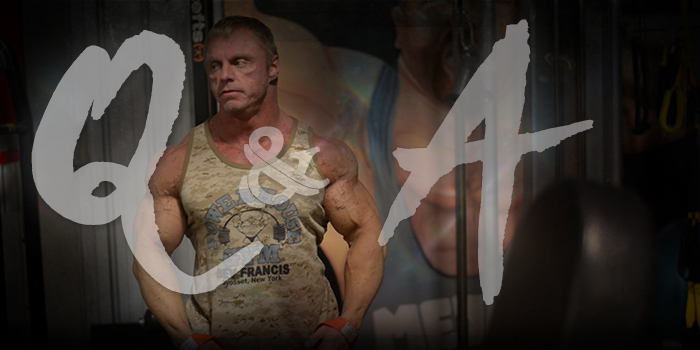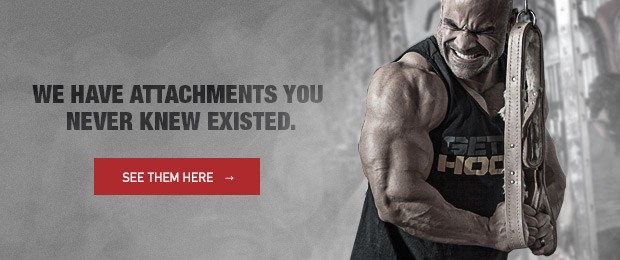
You have questions, team elitefts has answers. This article is a compilation of muscle-building questions asked by you, our readers, directly to members of team elitefts. In the last two months, we have covered squat, deadlift, and bench press topics, and intra-workout supplementation.
In this article, Brandon Smitley, Mark Dugdale, Josh Bryant, Harry Selkow, and Dave Tate answer questions about how to engage the upper back, rep ranges for muscle growth, chest size without heavy pressing, and core lift rotation to promote hypertrophy.
Upper Back Growth
Q: For some reason, my mid traps seem to grow slower than my lats. What back workout would be good for upper back/mid trap growth? It doesn't seem to be a mind muscle connection problem. I usually just chuck in some shrug variation at the end of my back workouts — I do 4-5 sets of anywhere between 20-40 reps. Thanks guys. — Anonymous
Brandon Smitley: Something that I feel in my mid back better than anything else is doing band pull aparts with my back on the bench while laying down. Hold the contracted position for a 2 count on each rep. Start with about 50 total reps, and work your way up to 100. Something about having a feedback from the bench really helps with a great contraction.
Also, make sure on your rowing movements that you aren't "shrugging" up while rowing. This is very common in people and they don't even realize it.
Rep Ranges for Size
Q: What is the best rep range for size? I've heard 4-6, 8-12, 5x10, etc.
Also with the rep ranges, is it best to do 5 sets of say ten reps all with the same weight? Or pick a rep range, say 5x8-12, and as soon as 12 reps can be completed increase the weight and start back at the lower end of the range?
I just feel like if I do 5 sets of 10 with the same weight then the first few sets are too easy to have any effect. — Anonymous
Brandon Smitley: Basically the bigger the movement, use lower reps, and vice versa. Based upon the exercises you can hit a nice variety of rep ranges. Don't pigeon hole yourself to one rep range. Mix things up and move by feel. If you are feeling sets of 20 that day for leg curls, have at it. At the end of the day, volume and time under tension are key. This is what acquires metabolic distress and thus stimulus for growth.
Josh Bryant: A recent study published in the Journal of Strength and Conditioning Research entitled "Effects of different volume-equated resistance training loading strategies on muscular adaptations in well-trained men" compared a high volume bodybuilding training regimen to a powerlifting training regimen. The subjects were 17 well-trained young men.
The bodybuilding group trained performing 3 sets of 10 reps with 90-second rest intervals, contrasted to the powerlifting group that performed 7 sets of 3 reps with a 3-minute rest interval. Over the 7 weeks of training, the powerlifting group made greater strength increases but there were no significant differences in the increase of muscle over the same period of time. The study concluded: both bodybuilding and powerlifting-type training promote similar increases in muscular size.
I copy and pasted that from an article I did--the point is to maximize muscle growth you gotta take a holistic approach! I highly recommend getting Built to the Hilt if you do not have it.
Harry Selkow: 8-15. Size is more about the TIME under tension. So sets, speed of movement, reps per set are all variables you can play with.
Chest Size Without Heavy Pressing
Q: After benching heavy for years, the full range bench and dumbbell bench are continually tweaking my left pec, no matter how I treat or rest it. I've come to the conclusion that I'm just going to ignore the movement and move on. I'm not going to compete again in either powerlifting or bodybuilding, but I want to keep some size in that area while focusing on back, shoulders, and legs. In other words, I want to look good when I take my kid to the pool. Here's what I can do without pain:
- Dips- sets of 25 or so
- Dips with a 45 added
- Pec Dec
- Push-ups
- Light-ish dumbells, slight incline, high reps, palms facing
— Antknee
Josh Bryant: If you can do dips weighted and some sort of flying movement--absolutely--Vince Gironda as well other have believed they are kind.
I would also try dumbbell floor flys.
I am trying to embed the video from my Instagram so you can see. I think you will still be able to strike fear and the hearts of men and prolonged feminine stares at the community pool L:)
Antknee: Josh- thanks SO much for that suggestion. I tried them and they worked with no pain and I was able to go surprisingly heavy with really good form. I finished each set with a few DB floor presses as they seemed OK as well. I've got all your books except the bench press, so I'm gonna look for a way to construct a good powerbuilding routine with floor flys and dips as the cornerstones for chest. Should be interesting.
Mark Dugdale: A couple thoughts as I torn my left pec a couple times...well, at least once for sure. Hex presses might be a possibility because you can keep your elbows tucked into your sides. This exercise really pumps up my chest, provides an intense contraction and doesn't require much weight.
Also if you can do push-ups and machine flys then perhaps stretch push-ups would be a possibility? I love doing them with a couple chains across the back of my neck, going to failure, dumping the chains and then going again to failure with bodyweight only. 4 sets of these and your chest will be blown up.
Hope this helps!
Programming for Size Gain
Q: When training to promote hypertrophy, is it important to train the same movements every workout? It makes things a bit more fun for me if I swap in new movements if I feel like it, or depending on equipment available at the gym I'm using that day. — Steve
Brandon Smitley: This should be fine. Hitting the muscles with different variations and movements is never a bad thing. Obviously, you want to build around the staples; squats, deadlifts, rows, pull ups, bench press, overhead work, etc. Now how you prioritize them is really up to you. John Meadows uses some methods of hitting hamstring work before squats and does more rack pulls than deadlifts from the floor, but it's still a big variation of the movements. But have some staples that you try to keep around for the most part. But you certainly don't have to do the exact same routine week in and week out.
Josh Bryant: I agree with Brandon about the "staples." That is powerbuilding! But from time to time you can rotate the "core" lifts too. So, squats become front squats, deadlifts become deficit deadlifts, etc. The other movements for advanced guys can be rotated every 1-3 weeks and for intermediates every 4-6 weeks or so.
Dave Tate: No, you do not have to. Brandon did a great job of answering this. One thing I do like about keeping some of the movements the same for 3-4 weeks is it gives you something extra to work toward (using more weight or getting more reps). I try to do this with a few movements every month - but that's just the X - Powerlifter in me.









